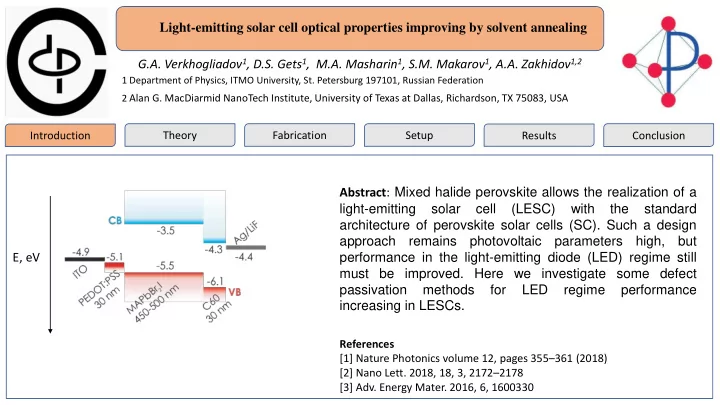

Light-emitting solar cell optical properties improving by solvent annealing Lab symbolics Lab symbolics G.A. Verkhogliadov 1 , D.S. Gets 1 , M.A. Masharin 1 , S.M. Makarov 1 , A.A. Zakhidov 1,2 or author photo or author photo 1 Department of Physics, ITMO University, St. Petersburg 197101, Russian Federation 2 Alan G. MacDiarmid NanoTech Institute, University of Texas at Dallas, Richardson, TX 75083, USA Introduction Theory Fabrication Setup Results Conclusion Abstract : Mixed halide perovskite allows the realization of a light-emitting solar cell (LESC) with the standard architecture of perovskite solar cells (SC). Such a design approach remains photovoltaic parameters high, but E, eV performance in the light-emitting diode (LED) regime still must be improved. Here we investigate some defect passivation methods for LED regime performance increasing in LESCs. References [1] Nature Photonics volume 12, pages 355 – 361 (2018) [2] Nano Lett. 2018, 18, 3, 2172 – 2178 [3] Adv. Energy Mater. 2016, 6, 1600330
Light-emitting solar cell optical properties improving by solvent annealing Lab Lab symbolics symbolics G.A. Verkhogliadov, D.S. Gets, M.A. Masharin, S.M. Makarov, A.A. Zakhidov Introduction Theory Fabrication Setup Results Conclusion Dualfunctional devices Electrically driven dipole layer formation High potential barrier for charge injection Under applied voltage organic cations with nonzero dipole momentum migrates to interface with C60 and form a dipole layer, which reduce the potential barrier. References References [4] Energy Environ. Sci. , 2017, 10 , 1950-1957 [5] arXiv:1910.12285
Light-emitting solar cell optical properties improving by solvent annealing Lab Lab symbolics symbolics G.A. Verkhogliadov, D.S. Gets, M.A. Masharin, S.M. Makarov, A.A. Zakhidov Introduction Theory Fabrication Setup Results Conclusion Spin coating Solvent annealing DMF and DMSO were used for a solvent annealing T = 100C t=20 min References [6] Nano Energy, Volume 28, October 2016, Pages 417-425
Light-emitting solar cell optical properties improving by solvent annealing Lab Lab symbolics symbolics G.A. Verkhogliadov, D.S. Gets, M.A. Masharin, S.M. Makarov, A.A. Zakhidov Introduction Theory Fabrication Setup Results Conclusion PLQY and PL lifetime measurements PLQY measurements scheme PL Lifetime measurements scheme I(t)=∑Ai*exp( -t/ti)
Light-emitting solar cell optical properties improving by solvent annealing Lab Lab symbolics symbolics G.A. Verkhogliadov, D.S. Gets, M.A. Masharin, S.M. Makarov, A.A. Zakhidov Introduction Theory Fabrication Setup Results Conclusion Solvent annealing Segregation suppression Intensity, PLQY, % (no PLQY, % PLQY, % mW/cm 2 solvernt) (DMF) (DMSO) 17.5 5.64 5.2 8.85 65.6 3.22 6.72 10.47 106 3.42 6.43 13.83
Light-emitting solar cell optical properties improving by solvent annealing Lab symbolics Lab symbolics G.A. Verkhogliadov 1 , D.S. Gets 1 , M.A. Masharin 1 , S.M. Makarov 1 , A.A. Zakhidov 1,2 or author photo or author photo 1 Department of Physics, ITMO University, St. Petersburg 197101, Russian Federation 2 Alan G. MacDiarmid NanoTech Institute, University of Texas at Dallas, Richardson, TX 75083, USA Introduction Theory Fabrication Setup Results Conclusion 1. Light-emitting solar cell optical parameters can be improved by grain surface modification and photoactive layer composition changing. 2. Solvent annealing leads to grain size increasing and reduce nonradiative recombination via defects. 3. Potassium halide and lead acetate addition provide blue shift of electroluminescence to visible range. g.verkhogliadov@metalab.ifmo.ru
Recommend
More recommend